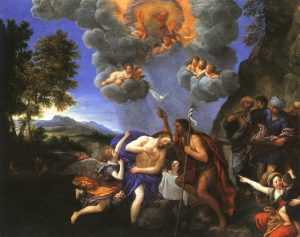
I wish I could recall where I read it now, but someone somewhere has written that Mark’s baptism scene is indeed his “birth” narrative of the Christ. Matthew and Luke might be seen as supplementing Mark’s gospel with a more “natural” birth, or at least one that had a flesh and blood Jesus come through the waters of the womb rather than the Jordan.
I found the idea interesting because it sits with the other Christological suggestions in this gospel — that Jesus was either adopted by God at baptism (adoptionism), or that the Son of God entered Jesus at baptism and from that moment there were two beings in one (separationism).
The Amplified Bible’s Mark 1:9-13
9In those days Jesus came from Nazareth of Galilee and was baptized by John in the Jordan.
10And when He came up out of the water, at once he [John] saw the heavens torn open and the [Holy] Spirit like a dove coming down [to enter] into Him.
11And there came a voice out from within heaven, You are My Beloved Son; in You I am well pleased.
12Immediately the [Holy] Spirit [from within] drove Him out into the wilderness (desert),
13And He stayed in the wilderness (desert) forty days, being tempted [all the while] by Satan; and He was with the wild beasts, and the angels ministered to Him [continually].
Jesus has no background. He is just a name. One might almost picture a Brian coming along one day to get baptized like everyone else was doing, and on emerging from the water he looked up to see the Ptolemaic sky being torn apart and a single spirit like dove (not two, as Aeneas was granted from heaven) swooping down and whooshing right into his very body. Thus possessed, Jesus next hears God speaking and pronouncing him to be his Son. Before Brian knows what’s happened he is driven off (like Azazel?) into the wilderness. The focus is on heaven as the active agency and the man baptized is a passive recipient of voice, vision and possession.
Could this be something of a metaphorical “new birth” story? The waters of baptism are a variation on a trope that can be found as far back as the Exodus and Red Sea event, or even (as Thompson suggests) with the parting of the waters by Elijah and Elisha in preparation for a new phase of ministry, the new world order that was ushered in by Noah’s Flood, and the very beginnings of life with the parting of the waters in the Genesis creation.
Was it to displace Mark’s image that suggested such a “birth” that was occasioned only at the moment of baptism that Matthew and Luke added their nativity scenes? (Or was Mark reacting against the nativity scenes and depicting something more to the liking of his own Christology? — just in case one day Markan priority is found not to be so cut and dried as it seems today.)
John does not need a nativity scene either, of course. His Word of God “became” flesh, but really had no birth, since he had been sitting or floating with God from the very beginning of everything.
Just thoughts, here. Sometimes nativity scenes are treated as evidence of the evolution of a Jesus biography. But it’s just as possible, I think, that their exclusion from Mark and John (as much as their inclusion in Matthew and Luke) has more to do with theology than with a simple adding of details to a tale over time.

